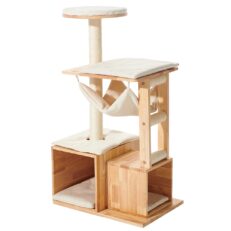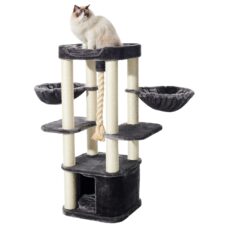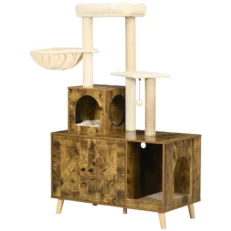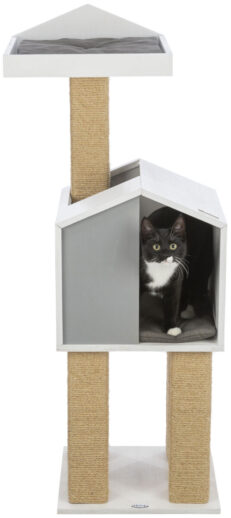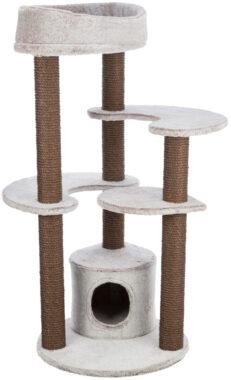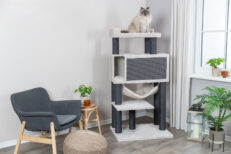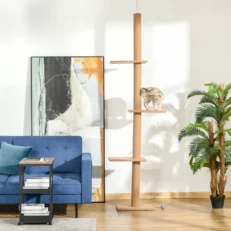
Meet the American Shorthair, the quintessential family feline with a lineage of vigor and utility. This breed, rooted in the early days of the American settlers, earned its keep as a skilled hunter, renowned for its contribution to pest control. Today, they continue to charm households with their robust health, affable nature, and easygoing temperament.
For such a historically active breed, a cat tree isn’t just an accessory; it’s an essential. The American Shorthair’s muscular build and agile prowess call for a robust and engaging cat tree that satisfies their instinctual need to survey, climb, and scratch. These hardy felines benefit immensely from the vertical space to leap and lounge, a nod to their ancestral roles of barn sentinels and ship mousers.
When selecting a cat tree for your American Shorthair, consider options that blend stability with a variety of activities. It should have multiple tiers to fulfill their exploratory tendencies and incorporate scratching posts that cater to their need to maintain claw health. Durability is key, as this working breed’s strength and constant use will test the tree’s resilience.
Moreover, the American Shorthair, while independent, is also known for its sociability. A cat tree placed in a living area allows them to interact with family members from their esteemed perches. Providing toys and puzzles on their tree can stimulate their intellect and satisfy the hunter within, keeping them physically fit and mentally sharp.
In essence, a cat tree for an American Shorthair should mirror their multifaceted personality: robust for their athletic side, stimulating for their sharp minds, and communal for their social hearts. With the right tree, these cherished family pets will thrive, demonstrating that even the most historic of feline hunters appreciate the comforts and challenges of a modern-day domestic jungle.
Understanding the American Shorthair’s Lifestyle: Versatility and Moderate Activity
The American Shorthair is a breed renowned for its versatility, adaptability, and moderate activity level. Let’s delve into the typical behavior and lifestyle of these charming feline companions:
Behavior and Activity Level:
Easygoing Nature: American Shorthairs are known for their easygoing and adaptable personalities. They tend to be friendly, sociable, and get along well with family members, including children and other pets. Their calm demeanor makes them suitable for various living situations.
Moderate Activity: Unlike some high-energy breeds, American Shorthairs have a moderate activity level. While they enjoy playtime and interaction, they are equally content to relax and lounge. They strike a balance between moments of activity and tranquil relaxation.
Independent Yet Affectionate: These cats are independent by nature but also form strong bonds with their human companions. They may enjoy sitting on your lap for cuddles but are just as happy finding a comfortable spot to observe their surroundings.
Adaptability and Cat Trees:
The adaptability of the American Shorthair is one of its defining traits. Here’s how a cat tree can cater to their moderate energy levels and adaptable nature:
Vertical Exploration: American Shorthairs may not be as inclined to climb and explore as some more active breeds, but they still appreciate vertical space. A cat tree with multiple levels provides them with opportunities to satisfy their curiosity by perching and observing from above.
Scratching and Play: Cat trees often come equipped with scratching posts and interactive features. This not only promotes healthy scratching behavior but also encourages play. American Shorthairs can engage in play and exercise at their own pace, making it ideal for their moderate energy levels.
Resting Spots: Cat trees offer comfortable resting spots, allowing your American Shorthair to relax while still being part of the household’s daily activities. These spots can be a source of comfort and security for them.
In summary, the American Shorthair’s versatile and moderate lifestyle is well-suited to a range of living situations. While they may not require the same level of activity as some breeds, providing them with a cat tree enhances their environment by offering opportunities for play, exploration, and relaxation. It allows them to enjoy their moments of activity while embracing their easygoing and adaptable nature.
Selecting the Ideal Cat Tree for an American Shorthair
When searching for the perfect cat tree for an American Shorthair, the goal is to merge their characteristic robustness and calm demeanor with a structure that meets their needs. Here’s what to consider to ensure you choose a cat tree that your American Shorthair will love and use.
Sturdiness: A Non-Negotiable Feature
American Shorthairs are muscular and strong cats, and their cat tree needs to reflect this. A sturdy cat tree is crucial to ensure safety and stability as they climb and play. Look for a cat tree with a wide base that prevents tipping, especially if your cat is on the heavier side.
Appropriate Height: Tailored to a Less Acrobatic Breed
While American Shorthairs can be playful, they are often less inclined to the daring leaps and acrobatics of some other breeds. Therefore, the height of the cat tree should reflect their moderate climbing abilities. A medium-height cat tree with easy-to-reach platforms will accommodate their activity level without overwhelming them.
Material and Durability: Built to Last
Since American Shorthairs are solid cats, the materials used in the cat tree must be capable of withstanding their weight and use. Look for cat trees that boast robust construction materials such as solid wood rather than particle board. The cover material should be of high quality as well, like thick carpeting or heavy-duty fabric, to endure frequent scratching and lounging.
Incorporate Scratching Posts: For Claw Health and Furniture Safety
Scratching is a healthy and natural behavior for all cats, including American Shorthairs. Ensure the cat tree includes multiple scratching posts covered in sisal rope or fabric, which provide the perfect texture for claw maintenance. These designated scratching areas can also deter your cat from using your furniture as a scratching post.
Comfort and Rest: A Cozy Retreat
American Shorthairs often enjoy lounging as much as playing. Including cozy beds or hammocks within the cat tree design gives your cat a comfortable spot to nap or survey their surroundings. This comfort aspect will make the cat tree a more enticing and frequently used piece in your home.
Interactive Elements: Engage Their Playful Side
While American Shorthairs are not the most hyperactive cats, they do enjoy interactive play. A cat tree with hanging toys or a dangling rope can provide much-needed entertainment and stimulate their hunting instincts. These elements will encourage your cat to engage with the tree for playtime.
Ease of Cleaning: A Practical Consideration
American Shorthairs shed moderately, so easy-to-clean surfaces are a must. Removable and washable pads, or a tree with surfaces that can be vacuumed easily, will help in maintaining a clean space for both your cat and your home.
American Shorthairs are a beloved breed known for their robust health, easy-going temperament, and enduring popularity. When it comes to their environment, it’s important to provide features that cater to their physical and mental needs. A cat tree can be a fantastic investment for an American Shorthair, as it can offer a dedicated space for scratching, playing, and resting. Here are the features that are particularly beneficial for American Shorthairs:
1. Durable Scratching Posts: American Shorthairs have a natural need to scratch, which helps them keep their claws sharp, enables them to stretch their muscles, and provides a form of territorial marking. A cat tree with a variety of scratching posts, including those wrapped in sisal rope or carpet, can be very appealing. Durability is key here, as scratching posts will see a lot of use over time.
2. Spacious Platforms and Perches: Considering that American Shorthairs can be medium to large cats, any platforms or perches should be spacious enough to accommodate them comfortably on a large cat tree. These areas provide the perfect spot for your cat to lounge and observe their surroundings. It’s also a great way for them to enjoy the sunshine next to a window or relax in a quiet corner of the house.
3. Interactive Elements: American Shorthairs are playful and intelligent, so incorporating interactive elements such as toys, tunnels, or dangling objects can stimulate their mind and keep them physically active. This is especially important for indoor cats who may not get as much exercise as outdoor cats. Toys attached to the cat tree can mimic prey, allowing them to engage in their natural hunting behaviors.
4. Stability and Safety: A cat tree for an American Shorthair should be solid and stable cat tree, as this breed can be quite powerful and active. A wobbly tree might discourage use and can pose a safety risk. Make sure the tree is well-balanced and can support the weight of the cat without tipping over.
5. Easy to Climb: While American Shorthairs are good climbers, not all are acrobatic daredevils. The cat tree should have easy-to-climb levels, especially for older cats who may not be as agile as they once were. Ramps or steps can be beneficial for these cats, ensuring they can still enjoy their cat tree without any struggle.
6. Suitable Materials: The materials used in the cat tree should be safe and non-irritating for your cat. American Shorthairs can have different preferences for where they like to scratch and rest, so having a combination of carpet, fabric, and wood can give them options to choose from.
7. Ease of Cleaning: American Shorthairs, like all cats, appreciate cleanliness. A cat tree with removable and washable covers or cushions is ideal as it allows for easy maintenance and ensures a hygienic environment for your pet.
By providing these features in a cat tree for an American Shorthair, you’ll help ensure that their natural behaviors are supported in a positive way, thus enhancing their quality of life. Additionally, the cat tree should be positioned in a part of the house where they can feel included in family life, as American Shorthairs are known for being social and enjoying the company of their human family members.
American Shorthairs are known for their easygoing nature, but like any cat, they can sometimes exhibit an independent streak that makes introducing new furniture, like a cat tree, an interesting challenge. To encourage your American Shorthair to use the cat tree, consider these strategies:
1. Location is Key: Place the cat tree in an area where your cat spends a lot of time. Cats like to be in the center of activity, so a corner of the living room or near a window with a view can be more enticing than a remote spot.
2. Introduce with Treats: Use treats to make the cat tree an exciting new discovery. Place treats on various levels of the tree to encourage exploration. The goal is to create positive associations with the tree.
3. Implement Catnip: If your American Shorthair responds well to catnip, sprinkle some on the base and on the platforms of the tree. The catnip will act as an attractant and can motivate your cat to climb and explore.
4. Hang Toys: Interactive toys can also draw your cat to the tree. Choose toys that you can hang from the platforms, which will move when batted, mimicking prey and stimulating your cat’s natural hunting instincts.
5. Engage in Interactive Play: Use a wand toy or laser pointer to lead your cat up and down the tree during play sessions. This not only encourages exercise but also shows your cat that the tree is an acceptable play area.
6. Start at a Young Age: If possible, introduce your cat to a cat tree while they’re still a kitten, as habits formed early on are more likely to stick. However, even older cats can learn to love a cat tree with the right encouragement.
7. Use Comfort Items: Place a favorite blanket or toy on the cat tree to make it smell familiar. This can make your American Shorthair feel more secure and willing to spend time on it.
8. Lead by Example: Sometimes, cats mirror their owner’s behavior. If they see you interacting with the cat tree, they may become curious and decide to investigate it themselves. Of course, don’t climb it yourself – but you can touch and lean on it to show it’s safe and interesting.
9. Positive Reinforcement: Whenever your cat uses the cat tree, offer plenty of praise and affection. Positive reinforcement can go a long way in convincing your American Shorthair that the cat tree is a great place to be.
10. Be Patient: Remember that cats often take time to warm up to new things. Don’t rush the process; allow your American Shorthair to approach the cat tree on their own terms.
By incorporating these strategies and understanding that every cat has their own unique personality and preferences, you can increase the chances that your American Shorthair will not only use but thoroughly enjoy their cat tree.



